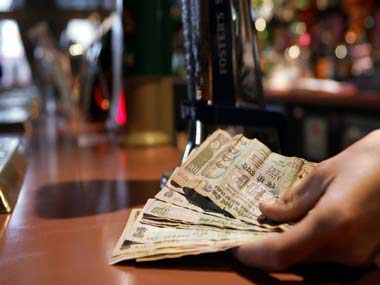India’s record high CAD (Current Account Deficit) of 6.7 percent of GDP for the third quarter of fiscal 2012-13 is worrisome but definitely not a cause for panic for the rupee.
For the record, CAD for the third quarter of 2012-13 at 6.7 percent of GDP was higher than the previous quarter’s level of 5.4 percent of GDP. In absolute terms, CAD was at $32.6 billion for the October-December 2012 period against a level of $22.6 billion seen in the July-September 2012 period. CAD stands at $71.7 billion for the first nine months of 2012-13, which is 5.4 percent of GDP. The full year 2012-13 will see CAD at record highs of well over 4.2 percent of GDP recorded in 2011-12.
[caption id=“attachment_681294” align=“alignleft” width=“380”] India’s CAD is nowhere in panic territory and is in fact being managed by capital flows. AFP[/caption]
India’s CAD is nowhere in panic territory and is in fact being managed by capital flows. AFP[/caption]
The reason experts worry about a high CAD is the effect of the deficit on the currency. If the CAD is not funded by capital flows, the currency will depreciate as the country draws down on its foreign exchange reserves to fund the CAD.
Depleting foreign exchange reserves lead to external debt ratios becoming unstable and this will in turn lead to a speculative attack on the currency, which will weaken the currency further. At some point of time a country that cannot fund its CAD will have to go to world lenders for loans. The other effects of a weak currency are inflation and flight of capital.
India’s CAD is nowhere in panic territory and is in fact being managed by capital flows. India’s external debt ratios are not showing any signs of instability though the ratios have weakened over the years. Markets are unlikely to go out and short the INR on the back of the CAD coming in at 6.7 percent of GDP. Hence one should not panic over the CAD numbers, especially since it is released with a three month lag and many factors can change in three months.
The record high CAD of $71.7 billion has been managed by capital flows of $70.7 billion in the April-December 2012 period. FII portfolio flows, ECBs (External Commercial Borrowing) and Short Term Trade Credits helped manage the high CAD. FII flows in Equity and Debt is around $9 billion in the April - March 2013 period indicating that the global risk appetite is still strong.
Indian corporates ranging from ICICI Bank to Bharti Airtel have raised close to $4 billion in the global bond market in the last three months. Credit spreads of Indian Issuers in the global markets are down by around 80bps over the last one year. Global lenders do have appetite to lend to Indian names indicating that credit flows from abroad will not be cut off in the near term.
India’s external debt as a percentage of GDP stood at 20.6 percent as of end December 2012. Short term debt to total external debt was 24.6 percent, though short term debt of residual maturity of less than one year was around 43 percent of total external debt. India’s external debt had gone up by 8.9 percent in the first nine months of fiscal 2012. The rising levels of external debt help in negating a high CAD.
However, external debt indicators of foreign exchange reserves to total external debt, which is down from 109 percent to 78.6 percent over the last six years and short term external debt to foreign exchange reserve, which has gone up from 12.9 percent to 31.1 percent have shown deterioration. Deterioration in external debt ratios heightens India’s vulnerability to global financial shocks.
The INR is down over 20 percent against the US Dollar over the last two years indicating the negative effects of a rising CAD. Capital flows have not helped the rupee and unless there is a drop in CAD, the rupee is unlikely to strengthen from current levels of Rs 54.3 to the Dollar. The question is will the rupee drop further from here? The rupee will not drop much further from here as the CAD is being financed by capital flows. If there is fresh aversion to risk globally due to issues such as eurozone sovereign debt crisis, then a fresh wave of weakness is likely on the rupee.
Net to net, despite worries on issues such as the Cyprus bailout, the rupee does not look vulnerable to the high CAD at current levels. In fact markets will tend to take profits or go short on the Dollar-rupee pair if there is further uptrend in the levels.
Arjun Parthasarathy is the Editor of www.investorsareidiots.com a web site for investors.
)